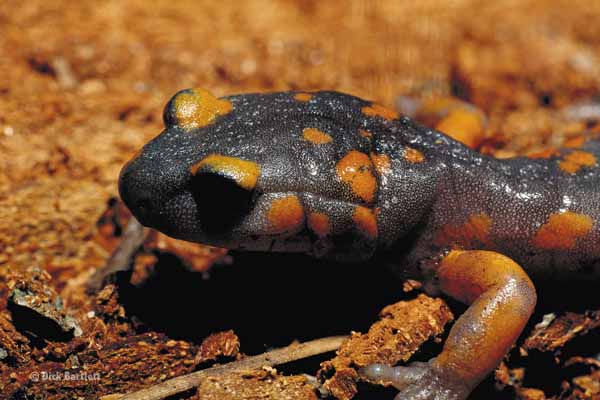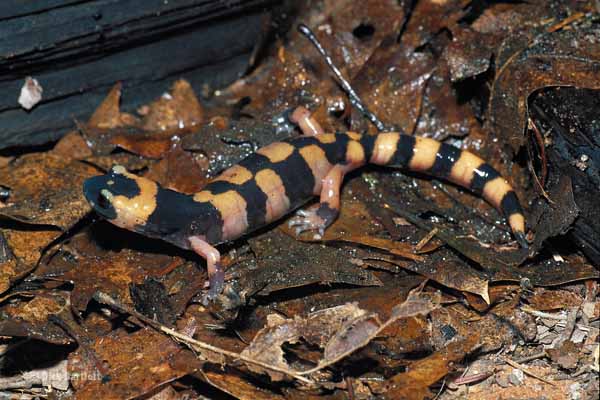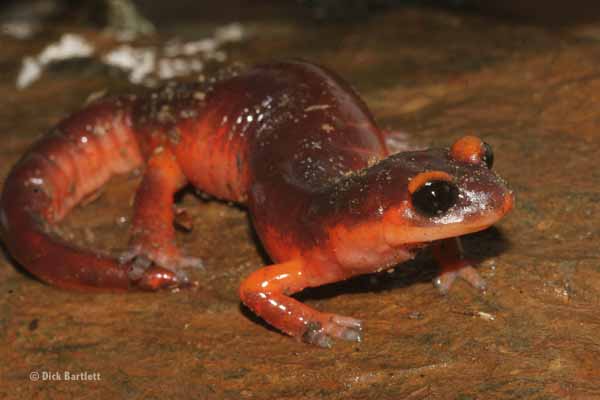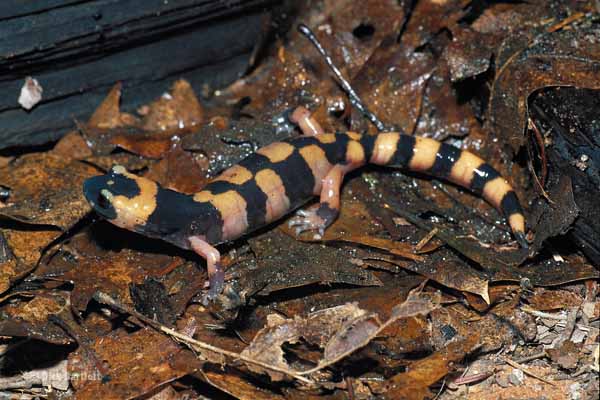Ensatina eschscholtzii, salamander, Plethodontidae
Although I live in north Florida, just a short drive south of Salamander Heaven (the Appalachian Mountains), I have never been content to search out only those caudatans so close to home. Rather, my interests and my travels have taken me from Florida to northern New England and from there across the breadth of the country.
Once on the “Left Coast”—the coast of the raging Pacific, giant trees, Sasquatch, the vining maple, the Hoh Rain Forest and banana slugs—I quickly learned that among all others there was one salamander species that was as spectacular as any of our diverse eastern species. This species was and is the fabled ensatina (Ensatina eschscholtzii), and once I knew it was there and was rather easy to find, I began my quest in earnest to know this creature better. Finding as many of its many subspecies, phases and patterns as possible became almost an obsession!
Read More
Field Research Adventures with the Red Hills Salamander

dick bartlett
If there is such a thing as a normal coloration in the Sierra Nevada ensatina, this is it.
My searches have taken me from the Mexican to the Canadian borders, throughout the coastal ranges, and from seaside forests to high into the Sierra Nevadas, all in the hopes of finding ensatina. And very fortunately (because the Pacific coastal states are a heck of a long drive from Florida), I was usually successful in finding those I sought.
What Are Ensatina?
The salamander genus Ensatina is contained in the family Plethodontidae, the lungless salamanders. Oxygen and carbon dioxide exchange is facilitated through the moist skin. Simply stated, if a plethodontid salamander’s skin dries, respiration becomes impossible and the creature dies.
With that said, it is important to realize that many plethodontids—ensatina included—are not creatures of the water. Instead, the moisture needed for life is absorbed through their skin being in contact with the damp soils, vegetation and fallen logs in fog-shrouded or rain-washed forests.
Adult ensatina can reach an overall length of about 6 inches, but are usually smaller. They range northward from northern Baja California to well up the coast of British Columbia. There are seven subspecies and immense areas of intergradation in the contact zones of the various subspecies.
The ensatina are thought to be most closely related to the better known and far more widely distributed woodland salamanders of the genus Plethodon. Most ensatina occur in forested areas where they seek seclusion beneath fallen trees (especially beneath bark shards) and rocks. Some populations exist amidst chaparral.
Ensatina move about the forest floor with their proportionately large heads raised up, seemingly alert to their surroundings. During cool, cloudy, moist, rainy or damp, foggy days, these little salamanders often prowl and forage during the daylight hours. At such times they may be nearly as often encountered on forest trails as in the fern-bedecked forests themselves.
A distinctive morphological character for identifying ensatina in the field is the presence of an easily discernable basal tail constriction. If severely stressed, either by environmental factors or a predator, the salamander discards (autotomizes) its tail at this constriction. Providing the salamander survives the trauma that initially caused the tail to be lost, tail regeneration may take more than a year to be completed.
Ensatina Subspecies
First, two words about identifying metamorphs: they’re tough. In almost all cases, the newly emerged babies and even some of the larger juveniles look nothing at all like the adults. Juveniles are often very dark with orange or yellow limbs. Use range as your primary identifying factor.

dick bartlett
It is hard to outdo a large-blotched ensatina when it comes to color and pattern.
Yellow-blotched ensatina (E. e. croceator): This is a beautiful black salamander with large yellow, yellow-green or cream spots with irregular edges. It occurs at moderate elevations in the Tehachapis and nearby ranges. This race may be found beneath fallen limbs and surface rocks in habitats as diverse as isolated mountain canyons, streamside talus, grassy meadows and urban fields.
Monterey ensatina (E. e. eschscholtzii): This dark-eyed subspecies may vary in color from brown to a beautiful and intense brownish-red. Subadults may be bright orange. It lacks contrasting blotches or bands. The belly is much lighter (often an off white, yellowish white or pinkish white) and contrasts sharply with the dorsal color.
Large-blotched ensatina (E. e. klauberi): A strongly patterned subspecies, this salamander occurs in montane situations in Southern California as well as in a disjunct population in the mountains of central-western Baja California. Thought by many to be the most spectacularly colored race, large-blotched ensatina usually have rather precisely delineated blotches and bands, and bars of creamy orange to bright orange against a ground color of black. The eyes are black. Albinos are known.
Oregon ensatina (E. e. oregonensis): This is the least colorful of the several forms and is considered a “morphotype” rather than a subspecies by many taxonomists. It has an olive tan to rather dark gray ground color and is peppered with light spots along each side. The eyes are dark. It ranges northward along the Pacific Coast to central British Columbia, Canada.
Painted ensatina (E. e. picta): Despite the picturesque name, even at its prettiest, this is not a brightly colored salamander. It has a ground color of olive buff to dark gray and is patterned laterally with irregularly arranged and variable amounts of darker and lighter pigment.
Sierra Nevada ensatina (E. e. platensis): This is the most variable subspecies, with an overall appearance ranging from just pretty to stunningly beautiful. The ground color is a purple-gray to black. The contrasting markings, most often in the form of spots, blotches, or vermiculations, are orange buff to bright orange. The orange coloration is sometimes so extensive that it all but obliterates the animal’s darker ground color. Pale, hypomelanistic examples are not uncommon.
Yellow-eyed ensatina (E. e. xanthoptica): Except for the yellow eye color, this race is very similar in appearance to the dark-eyed Monterey ensatina. The ground color may vary from brown to a beautiful and intense brownish-red. Subadults are often much more brightly colored than the adults. The belly is often off-white, yellowish-white, or pinkish white.
Where the ranges of two subspecies intersect, ensatina may or may not interbreed. When they do, the color and or pattern of the resulting offspring often look entirely unlike either parent. Again, rely on the range to assist in identification and to help establish probable parentage.
Procuring Ensatina
Ensatina are not the easiest salamanders for hobbyists to obtain. California, the state to which most of the subspecies are endemic, prevents commercialization of native herpetofauna and also regulates collecting and possession limits, so ensatina are not often seen for sale.
You may be able to collect your own, but before you do, be sure to check all pertinent non-game laws thoroughly. All laws are subject to periodic review and change, so remain up to date. Laws and regulations may change annually and remember that most city, county, state, and federal parks do not allow any collecting. Know and abide by your state’s laws.

dick bartlett
Although usually duller in appearance than the striking subadults, adult Monterey ensatinas are still very attractive.
Occasionally, Oregon ensatina are offered for sale online, and juveniles of other races are sometimes available from breeders. However, when they do appear, it will probably be necessary to act quickly because eager hobbyists usually quickly purchase all that are offered.
Ensatina Care
The terraria in which ensatina are kept may be very simple or quite complex. On the simple end of the spectrum, you may keep one or two in an escape-proof plastic sweater box with a footprint of 12 by 20 inches and a height of 3 or 4 inches. The substrate may be several layers of dampened (not wet) paper towels or an inch or two of moist (not sodden) sphagnum moss.
On the other end of the enclosure spectrum would be a complex woodland terrarium using a 10-gallon (or larger) aquarium with an escape-proof top. A soil substrate covered by growing mosses and shaded by potted plants may be provided (if commercial potting soils are used, be sure they do not contain vermiculite or pelleted fertilized additives). Again, the substrate should be just moist enough to allow the plants to survive, not actually wet or muddy.
No matter the terrarium type, a few shards of non-toxic bark (no cedar!) laid atop the substrate will be eagerly used by the salamanders as hiding areas.
Ensatina salamanders are cool-weather specialists. In their natural habitat, they may be surface-active wherever temperatures are moderate and moisture levels adequate, from the onset of the autumn rains throughout the winter and spring. I have found them to be most active on misty days or immediately following rains.
In summer, when temperatures elevate and or ground moisture levels are reduced, ensatina seek shelter in moisture-retaining structures such as decomposing logs, underground rodent burrows, cavities left by rotting tree roots, or beneath sizable boulders that are sunk far into the ground.
Several ensatina keepers have told me that these salamanders do well at room temperature. Perhaps if all other terrarium conditions are ideal—among them moisture levels, cleanliness and diet—ensatina may survive at room temperature, but having observed these salamanders in the wild and in woodland terraria in our facility, I believe ensatina are more comfortable, active and healthier at temperatures between 60 and 70 degrees Fahrenheit.
Because they have proportionately large heads, ensatina are able to eat larger food insects than the slender and woodland salamanders with which they share habitats. However, they may compete more closely with climbing and arboreal salamanders. In the wild, ensatina eat sow bugs; orthopterans; small, non-noxious millipedes; spiders; and even snails.
Captive adults thrive on small crickets, small waxworms and field plankton (insects from an insecticide-free area caught in a sweep net). Captive metamorphs and juveniles will require flightless fruit flies (Drosophila), springtails and other insects of similar size. The size of the feeder insects can be increased as the salamanders grow.
Insects should always be gut-loaded and lightly dusted once (for adult salamanders) or twice (for growing juvenile salamanders) a week with calcium-D3 powder prior to being offered to the salamanders.
Breeding Notes
Coastal populations of ensatina apparently breed during the winter and spring, whereas those from inland locations may breed in late spring and summer. The breeding sequences of salamanders in the wild are initiated by many naturally occurring climatic phenomena, including photoperiod, temperature and moisture suitability. The latter is especially important to terrestrial plethodontids such as ensatina, for they must ensure that the moisture at the egg deposition site will be adequately replenished to sustain the egg clutch, which usually contains six to 25 eggs, for the several months of incubation.
A satisfactory sequence of stimulating events must also be provided to captive salamanders if you intend to breed them.
The courtship of ensatina is lengthy and complex. It begins with a male sidling up against a female and rubbing her head and shoulders with his chin. The male then advances and the female trails him, rubbing his hip (sacral) region with her chin and straddling his tail. Once suitably stimulated, the male will deposit a spermatophore. The female picks up the spermcap with her cloacal labia and then seeks a suitable deposition site (a moist burrow, the moist interior of a rotting log or on the ground beneath a moisture-retaining log).
Plethodontid salamanders in general are considered difficult to breed in captivity. However, ensatina have been bred on numerous occasions by several hobbyists. It seems that those that breed most readily are maintained in terraria in protected outside locations (such as a cool, shaded porch or a sunroom with a natural photoperiod and a nearly natural progression of temperature variances).
It is hoped that as keeper expertise becomes honed with the various subspecies, ensatina will be available with greater regularity. These remarkable salamanders are well worth any special efforts that are needed to assure success.
Dick Bartlett has been keeping and breeding reptiles and amphibians for more than 60 years. He has had more than 650 articles printed and, with his wife Patti, has written more than 50 herp care, field guides and herp adventure books. In his spare time he is a birder and photographer. He currently resides in northcentral Florida.



